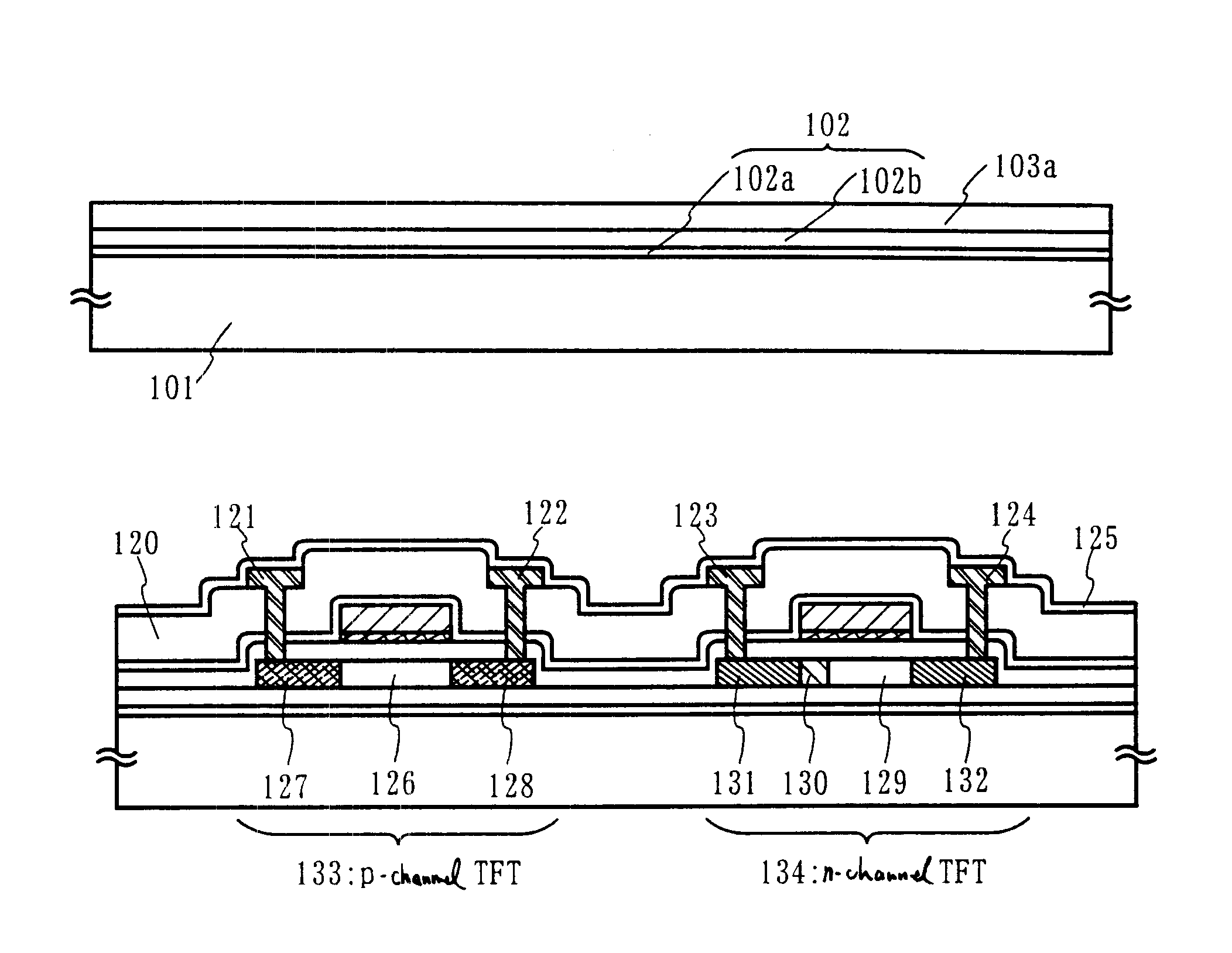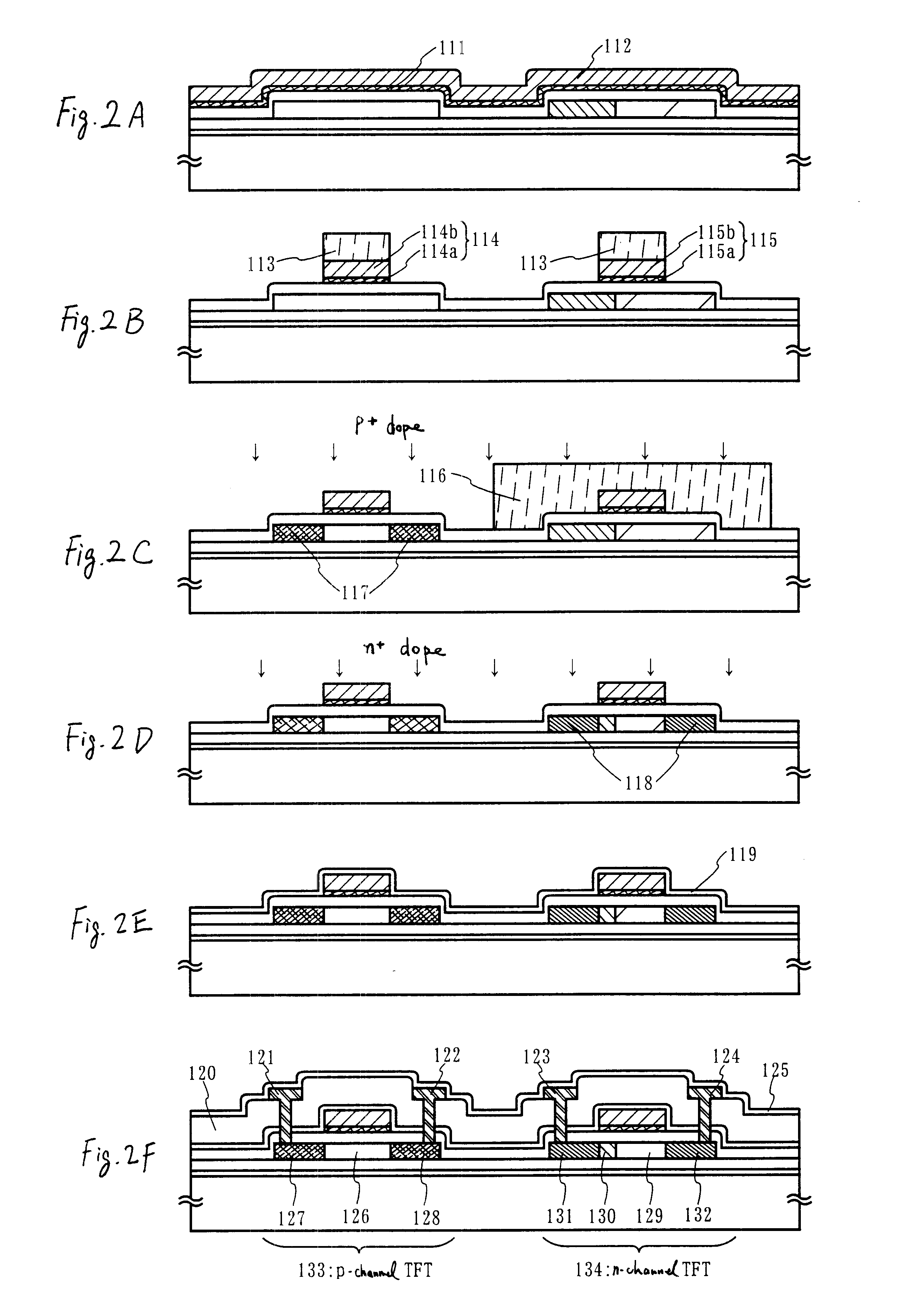Oxynitride laminate "blocking layer" for thin film semiconductor devices
a technology of oxynitride and semiconductor devices, which is applied in the direction of semiconductor devices, electrical devices, transistors, etc., can solve the problems of low power consumption, operation fault, and charge loss
- Summary
- Abstract
- Description
- Claims
- Application Information
AI Technical Summary
Problems solved by technology
Method used
Image
Examples
embodiment 1
Embodiment 1 of the present invention is explained using FIGS. 8A to 12. Here, a detailed explanation is made of a method of manufacturing a pixel TFT of a pixel portion, and driver circuit TFTs formed in the periphery of the pixel portion. Note that, in order to simplify the explanation, a CMOS circuit, which is the basic circuit for control circuits such as a shift register circuit and a buffer circuit, and an n-channel TFT forming a sampling circuit are shown in the figures.
A barium borosilicate glass substrate or an aluminum borosilicate glass substrate is used as a substrate 201 in FIG. 8A. An aluminum borosilicate glass substrate is used in embodiment 1. Heat treatment may be performed in advance at a temperature which is lower than the distortion point of the glass by 10 to 20.degree. C. A blocking layer 202 is formed on the substrate 201 by forming a silicon oxynitride film (A) 202a with a thickness of 50 nm on the surface of the substrate 201 on which the TFTs are formed, a...
embodiment 2
In embodiment 2, a process of manufacturing an active matrix liquid crystal display device from the active matrix substrate of embodiment 1 is explained. As shown in FIG. 18, an alignment film 601 is formed for the active matrix substrate in the state of FIG. 12. A polyimide resin is often used for the alignment film of a liquid crystal display device. A light shielding film 603, a transparent conducting film 604, and an alignment film 605 are formed on an opposing substrate 602. After forming the alignment films, a rubbing process is performed to give the liquid crystal molecules a certain fixed pre-tilt angle, bringing them into alignment. The active matrix substrate, on which the pixel matrix circuit and the CMOS circuit are formed, and the opposing substrate are then joined together by a sealing material or spacers (both not shown in the figures)in accordance with a known cell construction process. Next, a liquid crystal material 606 is injected between both substrates, and the ...
embodiment 3
FIG. 17 is a view showing an example of the arrangement of input-output terminals, a display region, and driver circuits of a liquid crystal display device. There are m gate wirings and n source wirings that intersect in a matrix shape in the pixel portion 406. For example, 480 gate wirings and 640 source wirings are formed when the pixel density is VGA, and 768 gate wirings and 1024 source wirings are formed for the case of XGA. The screen size of the display region becomes 340 mm for a 13-inch class in diagonal length, and becomes 460 mm for an 18-inch class in diagonal. It is necessary to form the gate wirings from low resistance materials as shown in embodiment 1 in order to realize this kind of liquid crystal display device. If the time constant (resistance.times.capacitance) of the gate wirings becomes large, then the response speed of the scanning signal becomes slow, and the liquid crystal cannot be driven at high speed. For example, when the material forming the gate wiring...
PUM
 Login to View More
Login to View More Abstract
Description
Claims
Application Information
 Login to View More
Login to View More - R&D
- Intellectual Property
- Life Sciences
- Materials
- Tech Scout
- Unparalleled Data Quality
- Higher Quality Content
- 60% Fewer Hallucinations
Browse by: Latest US Patents, China's latest patents, Technical Efficacy Thesaurus, Application Domain, Technology Topic, Popular Technical Reports.
© 2025 PatSnap. All rights reserved.Legal|Privacy policy|Modern Slavery Act Transparency Statement|Sitemap|About US| Contact US: help@patsnap.com



